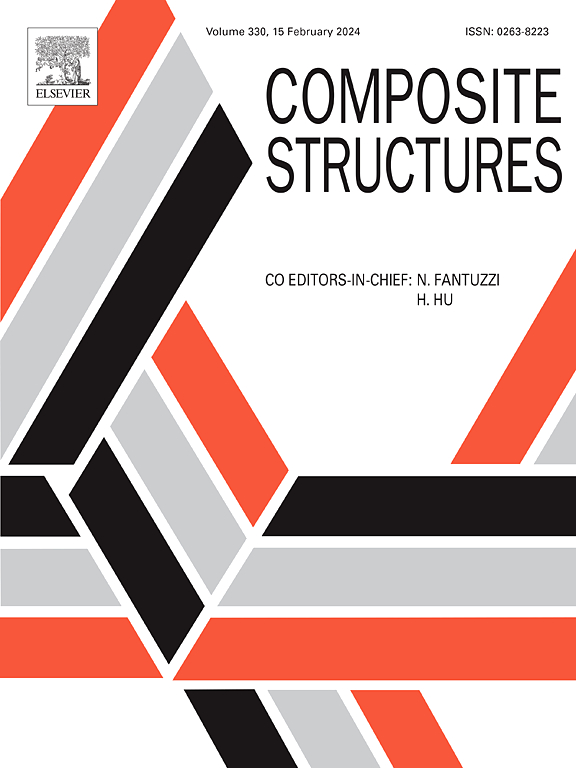考虑传感器位置和测量不确定性的精确鲁棒形状传感
IF 6.3
2区 材料科学
Q1 MATERIALS SCIENCE, COMPOSITES
引用次数: 0
摘要
形状传感是一种通过离散应变测量重建结构位移场的方法,广泛应用于航空航天、海洋、土木工程等领域。由于宏观变形是基于有限传感器测量的局部应变来评估的,因此传感器的放置在确保精确和鲁棒的形状传感中起着重要作用。在实际应用中,不可避免的和不可区分的测量不确定性会导致测量应变的偏差,从而导致重建过程中的重大误差甚至错误。因此,确定对测量偏差不敏感的合适传感器位置对于鲁棒形状传感至关重要。为了提高形状传感的精度和鲁棒性,提出了一种考虑测量不确定性的传感器优化布置方法。我们建立了传感器放置与重建精度之间的映射关系,以开发用于精确形状传感的传感器放置方案。此外,提出了一种基于稀疏网格数值积分(SGNI)的传感器安装误差和信号噪声等多重不确定性的量化方法。因此,导出了有效考虑测量不确定性的重构解析方程。基于上述工作,可以考虑多个测量不确定性对重建精度和鲁棒性的影响,对传感器位置进行优化。通过实验验证了所提方法的有效性,并通过具有代表性的复合材料变形重建仿真验证了所提方法对复合材料结构的适用性。本文章由计算机程序翻译,如有差异,请以英文原文为准。
Precise and robust shape sensing considering sensor placement and measurement uncertainties
Shape sensing, which involves reconstructing the displacement field of a structure from discrete strain measurements, is widely utilized in aerospace, marine, civil engineering, and other domains. Since macroscopic deformations are evaluated based on measured local strains by limited sensors, the sensor placements play a significant role in ensuring precise and robust shape sensing. In practical applications, inevitable and indistinguishable measurement uncertainties can lead to deviations in measured strain and subsequently result in significant errors or even mistakes during reconstruction. Therefore, it is essential to determine suitable sensor placements that are insensitive to measurement deviations for robust shape sensing. This paper proposes an optimal methodology for sensor placement considering measurement uncertainty with the aim of enhancing accuracy and robustness in shape sensing. We establish a mapping relationship between sensor placement and reconstruction accuracy to develop a sensor placement scheme for precise shape sensing. Additionally, a novel technique is presented for the quantification of multiple uncertainties, such as sensor installation errors and signal noise, based on Sparse Grid Numerical Integration (SGNI). Consequently, analytical equations for reconstruction effectively considering measurement uncertainties are derived. Based on the work mentioned above, the optimization of sensor locations can be performed by considering the influences of multiple measurement uncertainties on reconstruction accuracy and robustness. The effectiveness of all proposed methods is verified through experiments, and the applicability of the proposed method to composite structures is confirmed via a deformation reconstruction simulation of a representative composite material.
求助全文
通过发布文献求助,成功后即可免费获取论文全文。
去求助
来源期刊

Composite Structures
工程技术-材料科学:复合
CiteScore
12.00
自引率
12.70%
发文量
1246
审稿时长
78 days
期刊介绍:
The past few decades have seen outstanding advances in the use of composite materials in structural applications. There can be little doubt that, within engineering circles, composites have revolutionised traditional design concepts and made possible an unparalleled range of new and exciting possibilities as viable materials for construction. Composite Structures, an International Journal, disseminates knowledge between users, manufacturers, designers and researchers involved in structures or structural components manufactured using composite materials.
The journal publishes papers which contribute to knowledge in the use of composite materials in engineering structures. Papers deal with design, research and development studies, experimental investigations, theoretical analysis and fabrication techniques relevant to the application of composites in load-bearing components for assemblies, ranging from individual components such as plates and shells to complete composite structures.
 求助内容:
求助内容: 应助结果提醒方式:
应助结果提醒方式:


